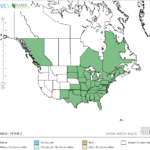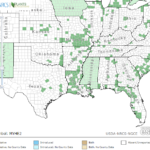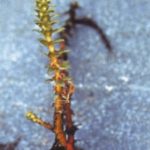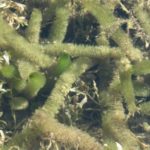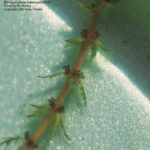Myriophyllum heterophyllum
USDA, NRCS. 2018. The PLANTS Database (http://plants.usda.gov, 28 March 2018). National Plant Data Team, Greensboro, NC 27401-4901 USA.
Illustration courtesy of University of Florida/IFAS Center for Aquatic and Invasive Plants. Used with permission.
What is Variable-leaf Watermilfoil?
Physical Characteristics
Leaves:
- Whorls of 4-6
Submersed Leaves:
- 0.78-2 inches long
- 0.78 inch spaces in between leaves
Emersed Leaves:
- Firm
- Sword- or elliptical- shaped
- 1.19 inches long
- 0.05 inches wide
Flowers:
- Whorls of 4-6
- Jagged edges
- About 0.05 inches long
- Up to 0.05 inches wide
- Petals 0.05-0.13 inches long
- 4 anthers, up to 0.09 inches long
- Emersed
- Up to 1.5 feet long, although usually shorter
Fruit:
- Disk-shaped
- 0.05-0.13 inches long and wide
Stem:
- Thick
Where Does it Grow?
Variable-leaf watermilfoil can be found in ponds, lakes, and streams.
Is it Invasive?
Although variable-leaf watermilfoil is native to North America, it is an aggressive invader because of its tremendous growth rate. Variable-leaf watermilfoil can completely takeover shallow ponds.
Pros and Cons of Variable-leaf Watermilfoil
Variable-leaf watermilfoil seeds and foliage are consumed by some ducks. Submerged portions of all aquatic plants provide habitats for many micro and macro invertebrates. These invertebrates in turn are used as food by fish and other wildlife species (e.g. amphibians, reptiles, ducks, etc.). After aquatic plants die, their decomposition by bacteria and fungi provides food (called “detritus”) for many aquatic invertebrates.
